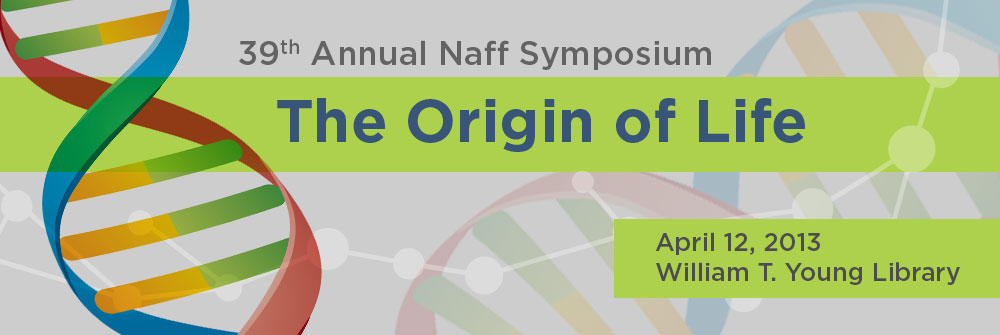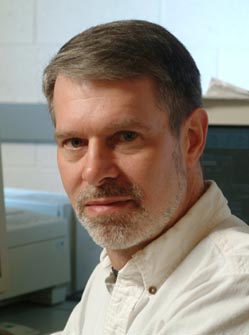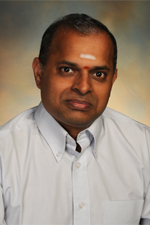
Schedule of Events - April 12th, 2013 |
|
|---|---|
| 8:00 a.m. | Registration & Continental Breakfast Keeneland Room, W.T. Young Library |
| 8:45 a.m. | Welcome Dr. Eli Capilouto, University of Kentucky President Auditorium, W.T. Young Library |
| 9:00 a.m. | Dr. Robert Hazen Genesis: The Scientific Quest for Life’s Origins Auditorium, W.T. Young Library |
| 10:00 a.m. | Break (refreshments available) Keeneland Room, W.T. Young Library |
| 10:30 a.m. | Dr. Ramanarayanan Krishnamurthy In Search of Alternatives to Understand the Emergence of RNA Auditorium, W.T. Young Library |
| 11:30 a.m. | Lunch |
| 1:30 p.m. | Poster Session Gallery, W.T. Young Library |
| 2:30 p.m. | Dr. Ada Yonath Origins of life: from prebiotic peptide bond formation to the contemporary ribosome Auditorium, W.T. Young Library |
| 4:00 p.m. | Award Ceremony |
Genesis: The Scientific Quest for Life’s Origins 9:00am, Auditorium of the W.T. Young Library Abstract: Is life’s origin a cosmic imperative manifest throughout the cosmos, or is life an improbable accident, restricted to a few planets (or only one)? Lacking observations of ecosystems beyond our own world, scientists seek experimental and theoretical frameworks to deduce the origin of life. In this context the concept of emergent systems provides a unifying approach. Natural systems with many interacting components, such as molecules, cells or organisms, often display complex behavior not associated with their individual components. The origin of life can be modeled as a sequence of emergent events – the synthesis of biomolecules, the selection and organization of those small molecules into functional macromolecules, the emergence of self-replicating molecular systems, and the initiation of molecular natural selection – which transformed the lifeless geochemical world of oceans, atmosphere and rocks into a living planet. This framework guides origin experiments, which can be designed to focus on each emergent step.
|
In Search of Alternatives to Understand the Emergence of RNA 10:30am, Auditorium of the W.T. Young Library Abstract: Though the emergence of RNA is viewed as a critical step in the origins of life field, our understanding of how (and why) RNA emerged in Nature is equivocal and continues to engage, intrigue and fascinate the imagination. From a purely chemical point of view the questions, in this context, are
The lecture will present our attempts towards an understanding gained by comparing the properties of RNA to its potentially (generationally simpler) natural alternatives. Such an approach not only discloses unconventional informational systems, novel chemical reactivity and reaction pathways, but – more importantly – provides an appreciation for the uniqueness of the structure and function of RNA in the context of chemical evolution.
Bio: Ramanarayanan Krishnamurthy is an Associate Professor of Chemistry at the Scripps Research Institute in La Jolla, and a member of the NSF-NASA sponsored Center for Chemical Evolution. He received his B.S. from University of Madras in 1984, M.S. from the Indian Institute of Technology, Bombay in 1986 working with Professor K. D. Deodhar, and Ph.D. from the Ohio State University in 1992 under Professor David Hart. After graduate work at Ohio State University, he was a postdoctoral fellow at the Swiss Federal Institute of Technology (ETH) with Professor Albert Eschemoser, where he remained until 1994. He then moved to La Jolla for a second postdoctoral experience at the Scripps Institution of Oceanography working with Professor Gustaf Arrhenius. He became a Senior Research Associate of the Skaggs Institute for Chemical Biology (1996-1997) and an Investigator (2005-2009). He joined the chemistry faculty of the Scripps Research Institute in 1998 as an Assistant Professor. His research is focused on the use of synthetic organic chemistry and methodology to experimentally address questions concerning the origins of life, as well as to develop tools for molecular bio-mimicry and chemical therapeutics. He has received the ISSOL Fellow Award (2011) and is a member of the NASA Astrobiology Science and Technology Instrument Development Review Panel since 2006, and the NASA Exobiology and Planetary Protection Research Review Panel since 2002.
|
Origins of Life: From Prebiotic Peptide Bond Formation to the Contemporary Ribosome 2:30pm, Auditorium of the W.T. Young Library Abstract: Ribosomes possess spectacular architecture accompanied by inherent mobility, allowing for their smooth performance as polymerases of amino acids. Peptide bond are formed and elongated within a universal semi-symmetrical region connecting all of the remote ribosomal features involved in nascent chain creation and elongation. The elaborate architecture of this region positions ribosomal substrates in appropriates stereochemistry for peptide bond formation, substrate-mediated catalysis, substrate translocation and nascent chain insertion into their exit tunnel. The high conservation of this region implies its existence irrespective of environmental conditions implying that it may represent an ancient RNA apparatus with bonding capabilities, which turned into peptide bond maker, thus capable of creating oligopeptides. Those oligopeptides that were found useful survived and triggered the formation of the genetic code, which was optimized simultaneously with the optimization of the bonding apparatus, namely the ribosome, as well as of the genetic code, its molecular tools and its products: the mature proteins.
|
2013 Naff Committee Members:
Professor Marcelo Guzman (Chair, Chemistry)
Professor Jason DeRouchey (Chemistry)
Professor Chris Richards (Chemistry)
Professor Anne-Francis Miller (Chemistry)
Professor Vincent Cassone (Biology)
For more information, contact Dr. Marcelo Guzman.

 Bio: Robert Hazen is a Research Scientist at the Carnegie Institution of Washington’s Geophysical Laboratory and the Clarence Robinson Professor of Earth Science at George Mason University. He received his B.S. and S.M. from MIT in 1971, and Ph.D. from Harvard University in1975. After studies as NATO Postdoctoral Fellow at Cambridge University, he joined the Carnegie Institution. Hazen is author of more than 350 articles and 20 books on science, history, and music. A Fellow of the American Association for the Advancement of Science, he has received the Mineralogical Society of America Award (1982), the American Chemical Society Ipatieff Prize (1986), the ASCAP Deems Taylor Award (1989), the Educational Press Association Award (1992), the Elizabeth Wood Science Writing Award (1998), and the Distinguished Public Service Medal of the Mineralogical Society of America (2009). He has presented numerous named lectures at universities and served as Distinguished Lecturer for the Mineralogical Society of America, and is a Past President of the Society. Hazen’s recent research focuses on the role of minerals in the origin of life, including such processes as mineral-catalyzed organic synthesis and the selective adsorption of organic molecules on mineral surfaces. He has also developed a new approach to mineralogy, called “mineral evolution,” which explores the co-evolution of the geo- and biospheres. In addition, he is Principal Investigator of the Deep Carbon Observatory, which is a 10-year international effort to achieve fundamental advances in understanding the chemical and biological roles of carbon in Earth’s interior. Hazen has also written widely for popular audiences, including articles in magazines such as Newsweek, Scientific American, New Scientist and The New York Times Magazine, and he appears frequently on radio and television programs on science. In addition to his scientific activities, Robert Hazen was a professional trumpeter until 2011. He performed with numerous prestigious ensembles including the Metropolitan, New York City, Boston, and Washington Operas; the Royal, Bolshoi, Jeoffrey, and Kirov Ballets; the Boston Symphony, the National Symphony, and the Orchestre de Paris.
Bio: Robert Hazen is a Research Scientist at the Carnegie Institution of Washington’s Geophysical Laboratory and the Clarence Robinson Professor of Earth Science at George Mason University. He received his B.S. and S.M. from MIT in 1971, and Ph.D. from Harvard University in1975. After studies as NATO Postdoctoral Fellow at Cambridge University, he joined the Carnegie Institution. Hazen is author of more than 350 articles and 20 books on science, history, and music. A Fellow of the American Association for the Advancement of Science, he has received the Mineralogical Society of America Award (1982), the American Chemical Society Ipatieff Prize (1986), the ASCAP Deems Taylor Award (1989), the Educational Press Association Award (1992), the Elizabeth Wood Science Writing Award (1998), and the Distinguished Public Service Medal of the Mineralogical Society of America (2009). He has presented numerous named lectures at universities and served as Distinguished Lecturer for the Mineralogical Society of America, and is a Past President of the Society. Hazen’s recent research focuses on the role of minerals in the origin of life, including such processes as mineral-catalyzed organic synthesis and the selective adsorption of organic molecules on mineral surfaces. He has also developed a new approach to mineralogy, called “mineral evolution,” which explores the co-evolution of the geo- and biospheres. In addition, he is Principal Investigator of the Deep Carbon Observatory, which is a 10-year international effort to achieve fundamental advances in understanding the chemical and biological roles of carbon in Earth’s interior. Hazen has also written widely for popular audiences, including articles in magazines such as Newsweek, Scientific American, New Scientist and The New York Times Magazine, and he appears frequently on radio and television programs on science. In addition to his scientific activities, Robert Hazen was a professional trumpeter until 2011. He performed with numerous prestigious ensembles including the Metropolitan, New York City, Boston, and Washington Operas; the Royal, Bolshoi, Jeoffrey, and Kirov Ballets; the Boston Symphony, the National Symphony, and the Orchestre de Paris.
 Bio: Ada Yonath is the Director of the Kimmelman Center for Biomolecular Assemblies and the Kimmel Professor of Structural Biology at the Weizmann Institute of Science in Israel. She received her B.S. in 1962, M.S. in 1964 both from the Hebrew University and Ph.D. from the Weizmann Institute in 1968. After graduate work, she accepted postdoctoral positions at the Carnegie Mellon University (1969) and MIT (1970). While a postdoc at MIT she spent some time at Harvard University in the lab of William Lipscomb, an alumnus from the University of Kentucky. In 1970, she started a protein crystallography laboratory in Rehovot at the Weizmann Institute of Science. She was a Lecturer at Tel-Aviv and Ben Gurion Universities between 1971 and 1978 and a Visiting Scientist at the University of Alabama (1974) and the University of Chicago (1977-1978). Yonath was also a Visiting Professor at the Universidad Austral of Chile (1978), and the Max-Plank Institute for Molecular Genetics in Berlin (1979-1983). She was successively promoted to Associate Professor of Structural Chemistry (1984) and Professor of Structural Biology (1988) at the Weizmann Institute of Science. Among other responsibilities, she was the Head of the Max-Plank Research Unit in Hamburg (1986-2004) and the Director of the Mazer Center for Structural Biology at the Weizmann Institute of Science (1988-2004). She is a member of several international academies such as the Israeli Academy of Sciences and Humanities, The European Academy of Sciences and the Art, The Korean Academy of Science and Technology, and the USA National Academy of Science. She is a member of many editorial boards and scientific committees such as the Scientific Advisory committee of the Center for Structural Biology at Argonne National Laboratory. Yonath has received honorary degrees and the most prestigious awards in Austria, China, England, France, Germany, India, Israel, Italy, Hungary, Japan, Norway, Panama, Poland, Sweeden, Switzerland, Taiwan, the United States of America, the Vatican, etc. Yonath's work aims to understand the mechanisms underlying protein biosynthesis, by ribosomal crystallography. Ada Yonath shared the Nobel Prize in Chemistry in 2009 with Venkatraman Ramakrishnan and Thomas Steitz. She contributed fundamental studies of the structure and function of the ribosome. Additionally, Yonath elucidated the modes of action of over twenty different antibiotics targeting the ribosome, illuminated mechanisms of drug resistance and synergism, and deciphered the structural basis for antibiotic selectivity.
Bio: Ada Yonath is the Director of the Kimmelman Center for Biomolecular Assemblies and the Kimmel Professor of Structural Biology at the Weizmann Institute of Science in Israel. She received her B.S. in 1962, M.S. in 1964 both from the Hebrew University and Ph.D. from the Weizmann Institute in 1968. After graduate work, she accepted postdoctoral positions at the Carnegie Mellon University (1969) and MIT (1970). While a postdoc at MIT she spent some time at Harvard University in the lab of William Lipscomb, an alumnus from the University of Kentucky. In 1970, she started a protein crystallography laboratory in Rehovot at the Weizmann Institute of Science. She was a Lecturer at Tel-Aviv and Ben Gurion Universities between 1971 and 1978 and a Visiting Scientist at the University of Alabama (1974) and the University of Chicago (1977-1978). Yonath was also a Visiting Professor at the Universidad Austral of Chile (1978), and the Max-Plank Institute for Molecular Genetics in Berlin (1979-1983). She was successively promoted to Associate Professor of Structural Chemistry (1984) and Professor of Structural Biology (1988) at the Weizmann Institute of Science. Among other responsibilities, she was the Head of the Max-Plank Research Unit in Hamburg (1986-2004) and the Director of the Mazer Center for Structural Biology at the Weizmann Institute of Science (1988-2004). She is a member of several international academies such as the Israeli Academy of Sciences and Humanities, The European Academy of Sciences and the Art, The Korean Academy of Science and Technology, and the USA National Academy of Science. She is a member of many editorial boards and scientific committees such as the Scientific Advisory committee of the Center for Structural Biology at Argonne National Laboratory. Yonath has received honorary degrees and the most prestigious awards in Austria, China, England, France, Germany, India, Israel, Italy, Hungary, Japan, Norway, Panama, Poland, Sweeden, Switzerland, Taiwan, the United States of America, the Vatican, etc. Yonath's work aims to understand the mechanisms underlying protein biosynthesis, by ribosomal crystallography. Ada Yonath shared the Nobel Prize in Chemistry in 2009 with Venkatraman Ramakrishnan and Thomas Steitz. She contributed fundamental studies of the structure and function of the ribosome. Additionally, Yonath elucidated the modes of action of over twenty different antibiotics targeting the ribosome, illuminated mechanisms of drug resistance and synergism, and deciphered the structural basis for antibiotic selectivity.